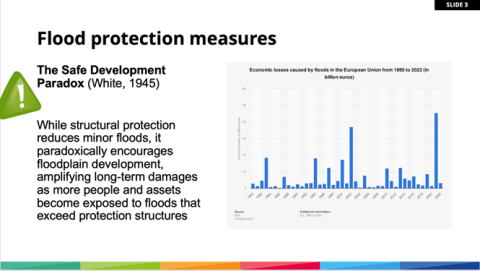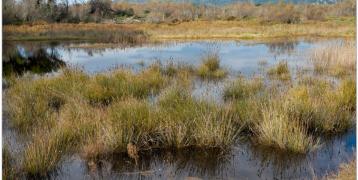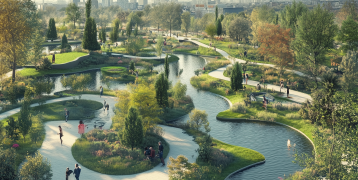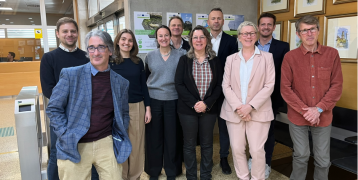Better flood protection for the Municipality of Sanski Most

On 27 February 2025, the Policy Learning Platform hosted a matchmaking session on better flood protection for the benefit of the Municipality of Sanski Most of Bosnia and Herzegovina. During the matchmaking, several key recommendations were shared by the peers Miguel Fernandez Mejuto, Head of Unit Water Technologies, Provincial Council of Alicante, Spain and Lies Deurinck, Expert Integrated Water Policy, Province of West-Flanders, Belgium to help Sanski Most to better protect itself from flooding.
Objective and context of the matchmaking
The experiences of the Municipality of Sanski Most with floods date back to 2014, when in May, floods damaged over 900 buildings and caused damage of over 4 million Euros. After the floods, the Municipality started analysing critical places on the watercourse of the Sana River and its tributaries, and measures were taken to widen and clean the riverbeds and to build protective barriers at critical places.
Considering that these were significant funds that exceeded the municipal budget, the Municipality carried out flood protection projects in cooperation with higher levels of government and government agencies in charge of natural disaster prevention, and to date, around 5 million Euros have been invested.
Policy Challenges
Due to the measures, the level of flooding and the related damages were significantly reduced. However, floods occurred again in 2019, and in 2022, heavy rainfall in Bosnia and Herzegovina caused the overflow of rivers, leading to flooding of roads other infrastructures, and facilities, as well as more than 300 homes in the north-western part of the country. The town of Sanski Most itself was flooded and road connections in and around Sanski Most were disrupted. The Mayor of Sanski Most declared a state of emergency due to the natural disaster.
Also in 2023, numerous homes were inundated in the Una-Sana Canton, with Sanski Most experiencing again significant damage, resulting in local officials declaring a state of emergency. In Sanski Most alone, 15 houses have been flooded, leading to the displacement of residents and an urgent need for assistance.
With the matchmaking ‘Better flood protection’, Sanski Most aimed to get some insights on the following specific questions:
- What types of flood protection measures such as nature-based solutions have you implemented in your region?
- What type of low-cost solutions can we realise at the municipal level and how can we best involve our citizens in these flood protection measures?
- How do you collaborate on a river catchment level?
Key insights shared during the matchmaking
During the matchmaking, several key recommendations were shared by the peers to help Sanski Most to better protect itself from flooding.
Important to focus upstream so protection comes before the flood reaches the city.
- Lowering the banks of the river close to the basin ensures that the peak of the flooding overflows into the basin before reaching the city.
- Building dykes allows to divert the flood to make it flow in the fields instead of the city. Dykes are built at strategic places thanks to computer modelling.
- Ensuring space for water course and for re-meandering
- Other options: uncovering buried watercourses, restoring wetlands, peatlands, and valleys, using your friendly neighbourhood beaver support.
As guardians of the soil, farmers are key players, and it is essential to focus efforts on them.
- Educate farmers about their practices and their consequences on the soil (plowing VS non-inversion tillage).
- Facilitate infiltration by growing green covers, setting alley cropping and grass buffer strips between ranks of crops.
- Focus on quality soil which will not only be beneficial for water permeability, but will also enable better yield.
- increase organic matter in the soil through organic mulching.
- small machinery is just as good and does not compact the soil as badly as big machinery
- improve soil life and soil regeneration through adaptation of crop and crop rotation
- Protect your groundwater: draining groundwater should be limited and alternatives could be explored (water level controlled drainage, water buffering, climate adaptive drainage). Metal plates positioned at strategic places to block drainage from ditches represent a cheap yet efficient way to limit drainage.
- Actively engage farmers in pilot projects, allowing them to gain firsthand experience and shift their mindset.
- Preserve and restore natural areas such as wetlands, woods and valleys to limit the impact of the flood.
- Consider alternatives to (mixed) sewage systems such as the Ladder van Lansink. There are many uses possible for the water collected before deciding to discharge it to the sea. For instance, the rainwater harvested can be used for public toilets, irrigating sports fields, cleaning cars etc. Water used by farmers for cleaning vegetables can be reused to water the fields.
- Involve citizens in the process. Encouraging citizens to use and collect rainwater will also raise their awareness about the water issue. As a side effect of building this water culture, the citizen’s daily use of water will be reduced (84l per person in Flanders).
- Consider other cheap yet ludic, and effective measures to involve citizens:
- Tile flipping contest between municipalities to boost water permeability
- Adopt a tree: by taking care of the tree, each citizen will make sure that the soil is good and will indirectly facilitate infiltration
- Set up green roofs and micro-dykes to avoid runoff, install deep gravel layers in your garden to facilitate infiltration etc.
- Urban planning and design also play a key role with a lot of alternatives to traditional structures:
- Roads that let water pass, infiltration/retention streets, green parking lots
- Open tree pits, infiltration facilities
- Grass between cobblestone, gravel grass, and grass grid in concrete are more permeable alternatives to regular paved streets and tarmac parks.
- Make soakaways mandatory for farmers and industry to get a permit
- Governance at River catchment - Case of the Yser basin: following the 2023 flood, a taskforce was set up to oversee the implementation of the EUR 80M action plan and improve collaboration at the level of the river catchment. “Resilient Westhoek” is chaired by the governor of the province and involves many actors such as municipalities and the Director of the De Vlaamse WaterWeg network. The taskforce, mandated by the Flemish government, is in direct communication with the river catchment board and collaborates closely with local stakeholders.
- Local governance: To decide on which farmer can get access to water concession, a commission composed of technical people, polder and municipality decides.
- Cross-country governance: The flood does not stop at the border. Set up crossborder/transnational mechanisms (example of the International Scheldt Commission including Belgium, France and the Netherlands). Make use of the Interreg programmes such as the IPA Cooperation Programme Croatia–Bosnia and Herzegovina–Montenegro, Interreg Danube Transnational Programme, Interreg Euro-MED Programme, and Interreg Europe.
- Safe development paradox: in case of big floods, structural protection is actually counterproductive. To face disasters as intense as Valencia (EUR 17 billion), you need a combination of all measures you can use, including green solutions.

- Leave space to the river, and sometimes (when green/grey measures are ineffective or too expensive) move out of the river’s territory. (see picture slide 5). Space left to the river is not lost space: attractive for citizen recreation, tourism etc.
- Use rain gardens & floodable parks to manage stormwater in residential areas. The water stored can be transferred to irrigation.
- Construction of natural barriers on sloped terrain can help to slow runoff and encourage water infiltration.
- Change of mindset, and message to convey to constituents:
- “NBS are not there to protect the environment, they are here to protect you and your company”.
- The cost of NBS is lower than grey infrastructure. And the cost of inaction is greater than the cost of action.
- Protection cannot be efficient without a flood risk culture. Not taking the risk seriously can have disastrous consequences: example of Valencia with unmaintained infrastructures, early warning system ineffective…
- A protocol has to be in place: in the case of Valencia, the person responsible was unaware, there was no streamlined protocol, the text of the message to be sent was not ready.
- Educate citizens not only about the risk itself, but also about the technical solutions in place, and how to react in case of flood.
- Involve citizens, and make them climate watchdogs, promoting the development of amateur networks and their integration with those of the administrations
- Raise awareness. We educate people about the risk of fire with alarm exercises in buildings. Japan also has shakeout drills for earthquakes. Similar exercises could be implemented in case of floods.










